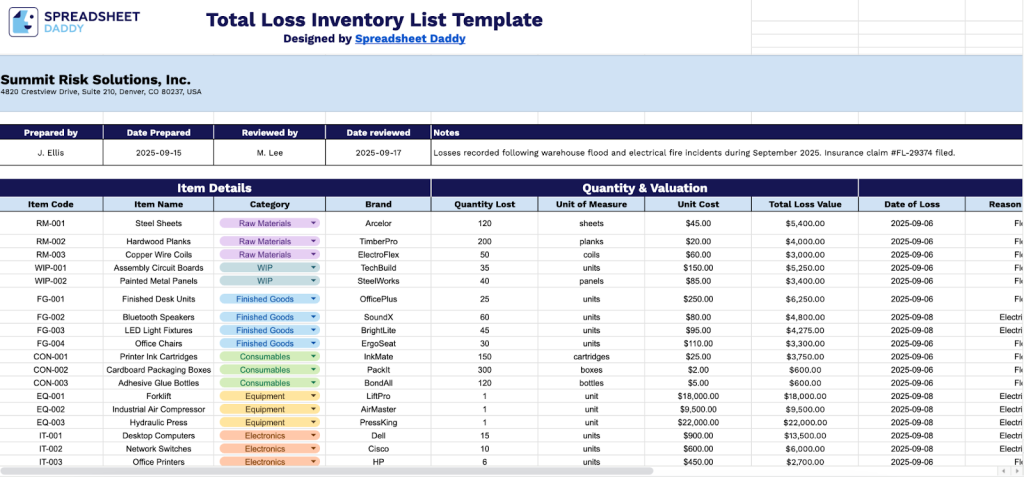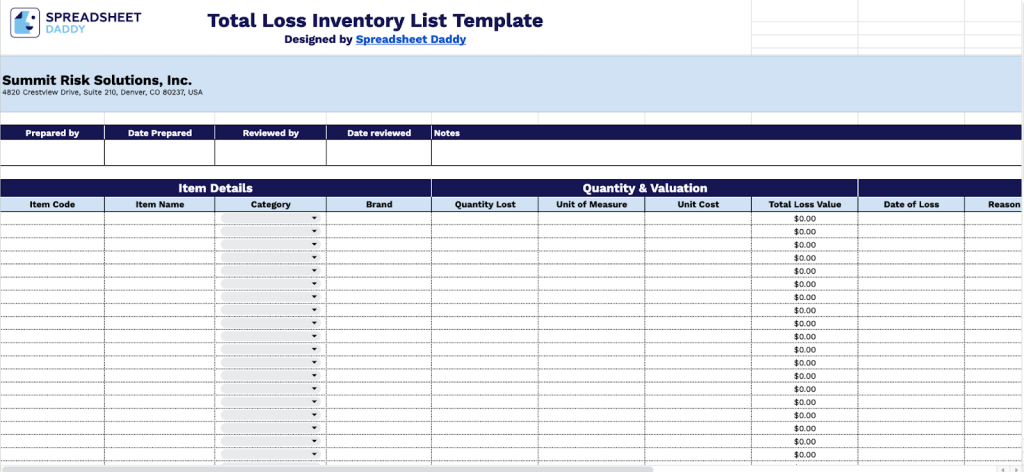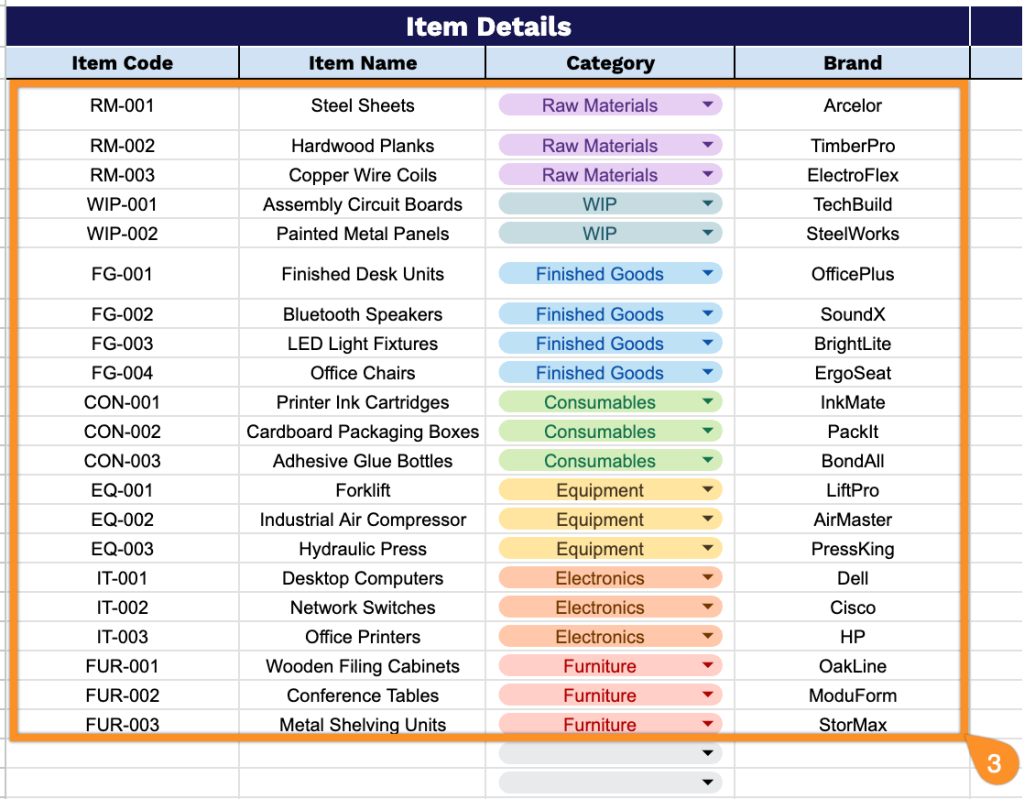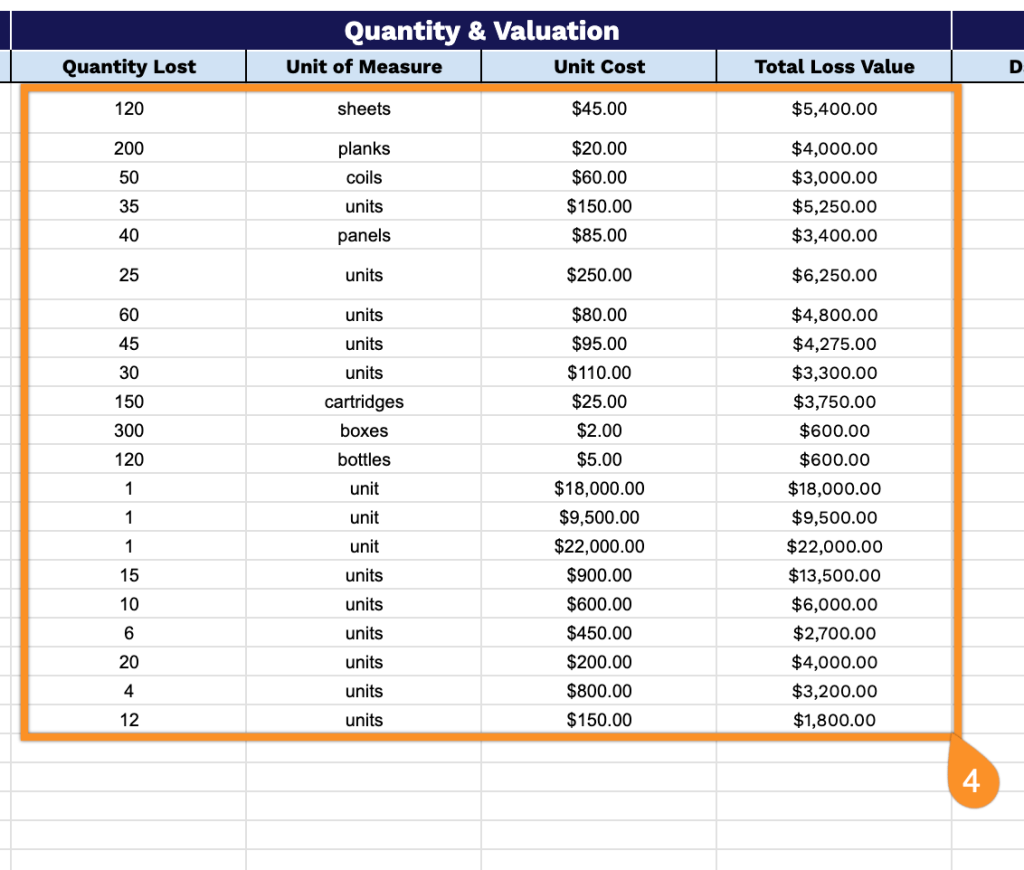Nobody wants to think about losing their belongings, but when disaster strikes, having a detailed inventory can save you time, money, and stress.
Our free Total Loss Inventory List Spreadsheet Template makes it easy to document your possessions with organized sections for items, values, purchase dates, and photos.
Available as a Google Sheets file for easy sharing, Excel format for offline use, or printable PDF, this template helps you catalog everything from furniture and electronics to jewelry and important documents.
Quick Jump
ToggleWhat Is a Total Loss Inventory Spreadsheet?

A Total Loss Inventory Spreadsheet is a detailed list of your belongings and their values, created after a disaster, such as fire, flood, or theft, destroys your property.
You list everything you owned, including furniture, electronics, clothes, and appliances, along with what you paid and what replacement would cost. Insurance companies use this to determine your payout, so the more detailed and accurate it is, the better.
Why Use Our Total Loss Inventory Spreadsheet Template?
- Streamline your insurance claims process: Our template helps you document losses systematically, reducing claim processing time and ensuring you receive fair compensation from insurance companies.
- Free and effortless setup: Download and start using immediately without any cost or complex installation, saving you time and money when you’re already dealing with the stress of a loss event.
- Maximize your recovery potential: The structured format captures all essential details, including item codes, valuations, and incident circumstances, helping prevent overlooked items that could cost you thousands in unclaimed losses.
Download Spreadsheet Daddy’s Free Total Loss Inventory Management Spreadsheet

Our Total Loss Inventory List Template is a comprehensive form designed to document and track items that have been completely lost or destroyed.
The template provides a structured format to record everything from basic item information and costs to incident details and reporting requirements.
What’s included
- Complete item tracking system: The template captures all the essential details you need, including item codes, names, categories, brands, quantities lost, units of measure, costs, and total loss values to document your inventory thoroughly.
- Incident documentation fields: There are dedicated spaces to record when losses occurred, why they happened, detailed descriptions of incidents, and who was notified so that you can maintain a complete record of each loss event.
- Built-in accountability sections: The header area includes fields for who prepared the document, preparation dates, reviewer information, review dates, and general notes, helping you maintain proper oversight and documentation standards.
- Ready-to-use calculation structure: The template comes with pre-formatted rows that automatically calculate total loss values, making it easy to see the financial impact of your losses without manual calculations.
How to Use Our Total Loss Inventory Spreadsheet Template
1. To access the table, copy it to Google Sheets or download it in Excel or PDF format.
2. Complete all required header information, including business name, location address, and inventory coordinator contact information, along with the date of completion. Document the supervising manager’s name and the date of their review. Use the Notes section to document significant observations.

3. Complete the Item Details section by documenting all essential product information for each lost item:
- Item Code: Enter the unique identifier or SKU that was assigned to each item for inventory tracking purposes.
- Item Name: Specify the complete product name and detailed description of the lost item.
- Category: Select the appropriate classification or department where the item belonged (electronics, furniture, equipment, etc.).
- Brand: Include the manufacturer, brand name, or supplier associated with the lost item.

4. Document the financial impact in the Quantity & Valuation section for accurate loss assessment:
- Quantity Lost: Record the exact number of units that were lost, damaged, or destroyed.
- Unit of Measure: Specify how the item is counted (pieces, pairs, sets, boxes, etc.).
- Unit Cost: Enter the original purchase price or current replacement cost per individual item.
- Total Loss Value: The template will automatically calculate the complete financial impact by multiplying the quantity lost by the unit cost.

5. Provide comprehensive incident documentation in the Cause & Circumstances section for insurance and accountability purposes:
- Date of Loss: Record the specific date when the loss was discovered or occurred.
- Reason for Loss: Select or describe the primary cause (theft, damage, natural disaster, spoilage, etc.).
- Incident Description: Provide a detailed narrative explaining how and where the loss occurred.
- Reported To: Document which authorities, insurance companies, or management personnel were notified of the loss.

6. Record detailed damage descriptions and relevant details in the Notes section to support accurate loss valuation.
